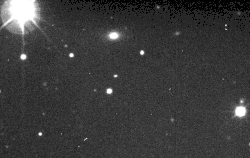Kiviuq (moon)
Kiviuq is a prograde irregular satellite of Saturn. It was discovered by J. J. Kavelaars[8] in 2000, and given the temporary designation S/2000 S 5.[9][10] It was named after Kiviuq, a hero of Inuit mythology.[11]
 Kiviuq imaged by the Canada-France-Hawaii Telescope in September 2000 | |
| Discovery[1] | |
|---|---|
| Discovered by | J. J. Kavelaars et al. |
| Discovery date | in 2000 |
| Designations | |
Designation | Saturn XXIV |
| Pronunciation | /ˈkɪvi.ʌk/ |
| S/2000 S 5 | |
| Adjectives | Kiviupian, Kiviuqian[2] |
| Orbital characteristics | |
| Epoch 2000 Feb. 26.00 Mean orbital parameters from JPL</ref> | |
| 11.111 Gm | |
| Eccentricity | 0.3288 |
| 449.22 d (1.23 yr) | |
| Inclination | 45.71 |
| Satellite of | Saturn |
| Group | Inuit group |
| Physical characteristics | |
Mean diameter | 17+50% −30% km[3] |
| 21.97±0.16 h[3][4] | |
| Albedo | 0.04[5] assumed |
Spectral type | B−V=0.87 R−V=0.66[6]/0.48[7] D-type[7] |
Kiviuq is about 16–17 km in diameter, and orbits Saturn at an average distance of 11.1 million kilometers in 450 days. It is a member of the Inuit group of irregular satellites. It is light red, and the Kiviupian (Kiviuqan)[2] infrared spectrum is very similar to the Inuit-group satellites Siarnaq and Paaliaq, supporting the thesis of a possible common origin of the Inuit group in the break-up of a larger body.[7][12]
Kiviuq is believed to be in Kozai resonance, cyclically reducing its orbital inclination while increasing the eccentricity and vice versa.[13]
The light curve amplitude of Kiviuq is large, varying in brightness by over 2 magnitudes. The large amplitude of Kiviuq suggests that it has an elongated shape, and may be a possible contact binary.[3]
Exploration
On 30 August 2010, the ISS camera of the Cassini–Huygens spacecraft took light-curve data from a distance of 9.3 million km. With these data, the rotation period was measured to 21 hours and 49 minutes.[4]
References
- Discovery Circumstances (JPL)
- The genitive form of Kiviuq is Kiviup. Thus the adjectival form could be absolutive Kiviuqian or genitive Kiviupian, parallel to nominative Venusian and genitive Venerian for Venus. See Inuktitut morphology
- Denk, T.; Mottola, S. (2019). Cassini Observations of Saturn's Irregular Moons (PDF). 50th Lunar and Planetary Science Conference. Lunar and Planetary Institute.
- T. Denk, S. Mottola, et al. (2011): Rotation Periods of Irregular Satellites of Saturn. EPSC/DPS conference 2011, Nantes (France), abstract 1452.
- Scott Sheppard pages
- Grav, T.; Holman, M. J.; Gladman, B. J.; Aksnes, K.; Photometric survey of the irregular satellites, Icarus, 166 (2003), pp. 33–45
- Grav, T.; and Bauer, J.; A deeper look at the colors of Saturnian irregular satellites
- Kavelaars, J. J., et al. The discovery of faint irregular satellites of Uranus Icarus 169 (2004), 474.
- IAUC 7521: S/2000 S 5, S/2000 S 6 November 18, 2000 (discovery)
- MPEC 2000-Y14: S/2000 S 3, S/2000 S 4, S/2000 S 5, S/2000 S 6, S/2000 S 10 December 19, 2000 (discovery and ephemeris)
- IAUC 8177: Satellites of Jupiter, Saturn, Uranus August 8, 2003 (naming the moon)
- Gladman, B. J.; Nicholson, P. D.; Burns, J. A.; Kavelaars, J. J.; Marsden, B. G.; Holman, M. J.; Grav, T.; Hergenrother, C. W.; Petit, J.-M.; Jacobson, R. A.; and Gray, W. J.; Discovery of 12 satellites of Saturn exhibiting orbital clustering, Nature, 412 (July 12. 2001), pp. 163–166
- Ćuk, M.; and Burns, J. A.; On the Secular Behavior of Irregular Satellites, The Astronomical Journal, Vol. 128 (2004), pp. 2518–2541
- Ephemeris from IAU-MPC NSES
.jpg.webp)
